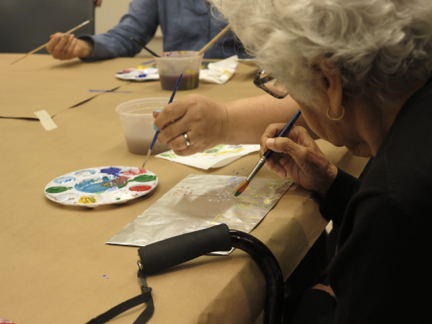“One day in Paris, I was accosted by a rather disheveled woman who shouted at me: ‘Give me some money!’ We started to talk. I learned that she had just come out of a psychiatric hospital; I realized quite quickly that she had immense needs and I became frightened. I had an appointment and I didn’t want to be late, so I gave her a little money and went on my way, just like the Pharisee and the Levite in the gospel parable of the good Samaritan. I was frightened of being swallowed up by her pain and her need. What is this abyss that separates people? Why are we unable to look Lazarus straight in the eye and listen to him?”
Jean Vanier writes this in Becoming Human, a book I have been reading – and have been repeatedly moved by – during my time here in New York City. It has been two weeks in the city and two weeks since I have begun my internship with Arts & Minds. To give some background, Arts & Minds is a program that aims to weave art into the lives of people living with dementia and their caregivers. Throughout the week, I attend a range of programs at a set of different museums in New York City. With each program, I am receiving answers to new questions. “How well does paint work on pieces of tin foil? Which train do I take to get to the Metropolitan?” I am confronting bigger questions, as well, like “How does dementia impact individuals?” In my interactions with people of varied ethnicities and backgrounds, I have found there is not a singular answer to that question. Dementia may make an individual more quiet, or more talkative, more sensitive, or more flirty. There are more logistical questions: How loud do I have to speak? Or how much can I say? These are questions that I may be able to get a bit closer to answering with experience and observation. As an intern, I have the gift of this extended time.
Each Arts and Minds programs follows the same sort of structure. We set up art supplies in the workspace, go over the day’s program, and wait for the attendees to arrive. This is a time for greeting one another, for gauging the energy and days of both the individual with dementia as well as their caregiver. Once we make our way into the gallery space, time is given to observe the art, to question it and to have bigger conversations. Once the conversation in the gallery space is concluded, we go to the studio art space. Everyone has time to create their own work of art. And then everyone has their time to share it. I believe that the beauty of the program is rooted in the way that a voice is granted to each of the participants. Participants, both people with dementia and their caregivers, are often refused a voice; Arts and Minds restores that power to them.
 The programs can pose discomfort and I believe that this is where the growth begins. When a person with dementia (PWD as they call it) might be having a difficult day, it is so much easier to look the other way. But what does this do? As Vanier observes, we are afraid to be touched. We are afraid to be tuned into the struggles that another is experiencing, but we are also tuned out of the beauty. Arts & Minds creates a space for both laughter and a space for seriousness. It is allowing me to be touched and encouraging me to question: why is it that we look away in the first place?
The programs can pose discomfort and I believe that this is where the growth begins. When a person with dementia (PWD as they call it) might be having a difficult day, it is so much easier to look the other way. But what does this do? As Vanier observes, we are afraid to be touched. We are afraid to be tuned into the struggles that another is experiencing, but we are also tuned out of the beauty. Arts & Minds creates a space for both laughter and a space for seriousness. It is allowing me to be touched and encouraging me to question: why is it that we look away in the first place?
While the Arts and Minds programs allow me to get to get closer to new insights, I find myself leaving with more questions than I came with. These questions are not contained to the programs. You see, once I leave the program, I usually take the subway home. On the subway, it is not unusual for people to pass through and ask for money. On the walk home, it is not unusual to pass individuals on the sidewalk who are homeless. In fact, this is quite common. And it’s as if I hear Vanier asking me, “Why are unable to look Lazarus straight in the eye and listen to him?”
In the museum programs, I am able to look individuals in the eye and listen to them. But once I leave, why do I try so hard to look the other way? This is a crucial question to be asked. Vanier comments on the discomfort that people feel in the presence of disability, the fear and avoidance that persists. I am not exempt from this response. Vanier illuminates the beauty in keeping one’s eyes open, upon truly seeing the other, in much the same way that the Arts & Minds program teaches to me. As I move forward in my internship, I hope to seek out encounters and conversations, not only with Arts and Minds participants, but with the bigger community of those living around me in New York City.
